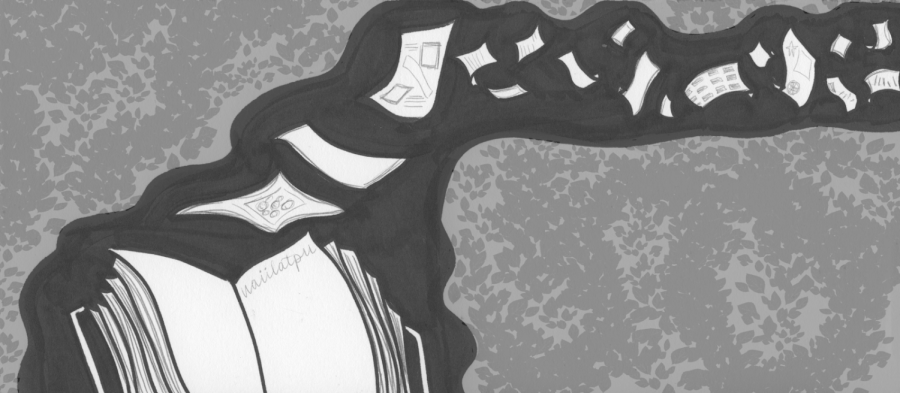Tracking the demise of the Whitman yearbook
February 4, 2020
After years of budget cuts and vacillating student interest, Whitman’s yearbook, previously known as Waiilatpu, went quietly out of publication in 2017. Its discontinuation has repercussions for both the Alumni Association, which utilizes the yearbook in their reunion efforts, and the Penrose Library Northwest Archives, where all issues are held and used as a resource for classes.
According to the Penrose Library Archives, this is not the first time publication has stopped. In fact, the yearbook’s publication has always been sporadic. The first issue of Waiilatpu was published in 1906, but as student interest fluctuated, issues were released less consistently. This irregularity began in the 1970s, and no issues were released between 1997 and 2011. However, in 2011, it was revived for a few years until the most recent publication in 2017.
As of 2016, the production team stopped using Waiilatpu as the cover and organization name. The first page of the 2016 issue explains the misunderstood history and meaning of the name. It was commonly thought that Waiilatpu meant “place for rye grass.” The word was the original name of the Whitman Mission. However, Marcus Whitman’s attempts to translate the Cayuse Nez Perce language into English distorted the meaning and spelling of the word, creating a legacy of historic inaccuracies that dominated the discourse.
The production team wrote, “[for] millennia, the people commonly known as the Cayuse called themselves Weyíiletpuu… it is not fitting for us to use an indigenous name that the Cayuse use(d) in reference to themselves. Historically this word is not used with due respect or diligence to the Cayuse; rather, its misuse symbolizes a false and racially prejudiced narrative which overshadows a tragic history…This yearbook does not claim to represent the Weyíiletpuu, and as such, we do not believe that calling our organization ‘Waiilatpu’ is an accurate or respectful tradition.”
Penrose Library Associate Archivist Dana Bronson explained how the discontinuation of yearbook issues will impact Whitman’s archives and conversations about the school’s history.
“The yearbooks provide an important window into student life at Whitman, and we will be losing that piece of our institutional memory with its discontinuation,” Bronson said. “However, it is important to note, that the yearbooks often reflect the particular values of the year that they are commemorating, and in some cases that does include racist and discriminatory language and imagery. Archivists work with faculty members to facilitate conversations about this history.”
Waiilatpu was an ASWC-funded program, much like blue moon and Quarterlife. Influenced by the lack of student interest, a dramatic decrease in funding perpetuated the yearbook’s detachment from the organization, guiding the stop in publication.
A Wire article published in October 2013 described ASWC’s reassessment of funds for Waiilatpu.
“Due to low student interest and involvement, ASWC attempted to allocate ‘Waiilatpu’ only $150 in this year’s budget, down from $13,350 in the 2012-2013 academic year,” the article stated. “This would have practically eliminated the yearbook, and while ‘Waiilatpu’ staff managed to avoid this fate and convince ASWC to raise its funding to $3,500, it still faces a significant budget shortfall.”
Director of Alumni Relations Nancy Mitchell described the significance of the yearbooks to the alumni community. The alumni office utilizes the yearbooks in their outreach efforts and as a way to enhance the experience of reunions. For instance, they comb through old photographs as a way to ensure that everyone receives invitations to affinity group reunions if the rosters from decades ago are incomplete. The yearbooks enable stronger connections between alumni and the school.
“Some of the older classes ask us to include photos from the yearbook on their name tags for reunions, because they will see someone, and it really helps to have their younger picture there,” Mitchell said.
Mitchell reflected upon the potential reasoning for the decrease in student interest.
“[New] technology and all of the photos we keep and take every single day has replaced the need for it, so it’s not a surprise to me that the yearbook has faltered,” Mitchell said. “As time moves on, traditions tend to fade.”
Despite a decrease in the need for print photos, they continue to retain meaning and play a significant role in sustaining memories and relationships.
“[Old photographs] help facilitate conversation during the reunion, [it] brings back memories of things that you did that you forgot about, and it reminds you of people you’ve forgotten. Those visual cues are really important in connecting people,” Mitchell said.
All publications of the yearbook are available in the archives; moving forward, it remains to be determined if student interest will arise once more.





